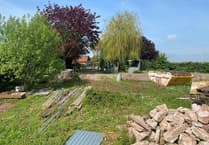AN ambitious plan to redevelop the Chase Hotel site in Ross-on-Wye with a £20million housing development has been submitted to Herefordshire planners.
The proposed residential development features 29 dwellings, including a number classified as ‘affordable’.
The application includes the conversion of the front section of the historic hotel into five apartments; the demolition of the hotel’s modern extensions; the erection of an accommodation block comprising of 10 apartments and the construction of 14 dwellings.
Also proposed is a redesign of the site’s infrastructure and landscaping.
Matt Tompkins of Tompkins Thomas Planning, the agent for the owner Camanoe Estates Ltd, explains that the original approach for the redevelopment of the Chase Hotel site in November 2018 was to provide a large number of low cost starter apartments housed in apartment blocks complimented by a restored/retained hotel building.
“However, much has changed since then,” said Mr Tompkins who has presented a new proposal to Herefordshire Council.
Mr Tompkins said: “The retained hotel forms the centrepiece of the development. The appearance of the proposed development has been carefully considered to create a coherent architectural vernacular across the site, completing the historic character of the retained hotel and reinforcing the parkland setting.
“The overall approach adopts a restrained, classically influenced style with rendered or brick facades, white-painted sash windows, hipped slate roofs, and detailing drawn from both the original hotel building and the wider Ross Conservation Area.
“While each element of the scheme has its own identity, they share common proportions, materials, and detailing to ensure a harmonious composition.
Mr Tompkins stated that the Georgian and Victorian phases of the hotel are to be restored to their original proportions following the removal of later, unsympathetic extensions.
The elevations to the front and east remain largely unaltered, showcasing their historic sash windows, balanced fenestration, and classical detailing.
“The reconstructed west and rear elevations take cues from surviving features, ensuring that the reintroduced fabric is sympathetic and seamlessly integrated,” said Mr Tompkins.
“This work reinstates the elegance of the original building, with the setting enhanced by the removal of extensive tarmac parking areas and the introduction of landscaped gardens.”
The proposed apartment block is designed as a subservient, but complementary neighbour and would share the classical influences of the approved apartment block.
The proportions have been carefully considered so that the block steps down in height towards the hotel, ensuring it does not dominate or compete visually.
The planning application states that the proposed dwellings will adopt a traditional townhouse form.
Mr Tompkins added: “This varied arrangement, combined with a consistent use of materials and detailing, reinforces the parkland character while providing high quality architectural diversity.
“The Mews houses to the west of the hotel are designed as close relatives of the adjacent Channing Mews, sharing the same eaves and ridge heights and other building cues.
“Their cottage-like proportions and detailing create a softer, more domestic scale at this edge of the site, blending easily into the existing landscape.”
Comments can be made on the application, number P252564/F via Herefordshire Council’s planning portal until Thursday, October 23.





Comments
This article has no comments yet. Be the first to leave a comment.